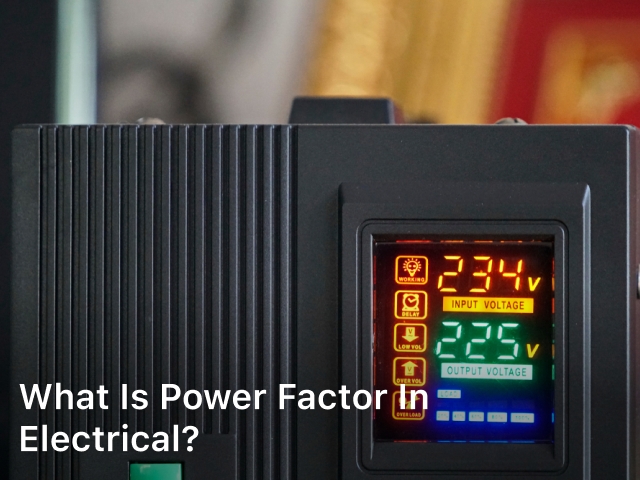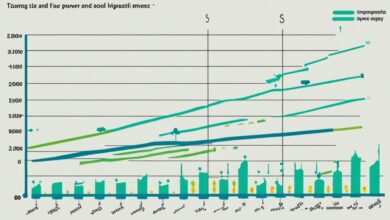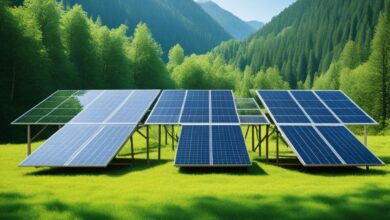
greentechinnovate.com. What is Power Factor in Electrical? – Learn all about What is Power Factor in Electrical? in this comprehensive guide. Understand its importance, calculation, and practical applications.
Electricity is an integral part of our modern lives, powering our homes, industries, and technology. While we often take it for granted, there’s a complex science behind the distribution and consumption of electrical energy.
One critical aspect of this science is the power factor in electrical systems. In this article, we’ll dive deep into the world of power factors, exploring their definition, significance, calculation, and practical applications.
Power factor is a crucial concept in the realm of electrical engineering. It measures the efficiency of electrical power usage in a system. Understanding power factor is essential for both residential and industrial settings, as it can significantly impact energy costs and equipment performance.
What is Power Factor in Electrical?
Power factor, often denoted by the symbol “PF,” is a dimensionless number between 0 and 1. It represents the ratio of real power (useful power that performs work) to apparent power (the total power flowing in a circuit). In simple terms, it tells us how effectively electrical power is being used in a system.
A power factor of 1 indicates perfect efficiency, meaning all the electricity supplied to a system is being used for useful work. However, in real-world scenarios, power factors are typically less than 1, indicating some energy is lost due to reactive power, which doesn’t perform useful work.

Why is Power Factor Important?
Understanding the importance of power factor is essential, as it has several significant implications:
1. Efficient Energy Use
A high power factor signifies efficient energy usage, reducing wastage and lowering electricity bills.
2. Equipment Performance
Low power factors can cause voltage drops, leading to equipment inefficiencies, overheating, and shorter lifespans.
3. Utility Charges
Many utilities charge industrial customers based on their power factor. A poor power factor can result in higher electricity bills.
4. Environmental Impact
Efficient power usage reduces carbon emissions, contributing to a greener environment.
Calculating Power Factor
To calculate power factor, you need to know two values:
- Real Power (P): This is the actual power consumed by the resistive elements in the circuit, measured in watts (W).
- Apparent Power (S): This is the total power supplied to the circuit, measured in volt-amperes (VA).
The power factor formula is straightforward:
Factors Affecting Power Factor
Several factors can influence power factor in electrical systems. Some of the most common ones include:
- Inductive Loads: Devices like electric motors and transformers introduce inductance, which can lower power factor.
- Capacitive Loads: Capacitors can improve power factor by providing reactive power.
- Harmonics: Non-linear loads can introduce harmonics, affecting power factor.
- Load Variations: Fluctuations in the load can impact power factor.
Practical Applications
Power factor correction is essential in various industries to optimize energy consumption. Some practical applications include:
1. Industrial Plants
Maintaining a high power factor in industrial plants reduces energy costs and prevents equipment damage.
2. Renewable Energy
In renewable energy systems, power factor correction ensures efficient energy conversion and distribution.
3. Commercial Buildings
Power factor correction devices are used in commercial buildings to improve energy efficiency and reduce electricity bills.
4. Residential Settings
While less common, power factor correction can benefit residential homes with multiple appliances.
What is a good power factor number?
A good power factor number is typically close to 1.0 or 100%. Power factor is a measurement of how efficiently electrical power is being used in a circuit. It is expressed as a decimal or percentage, ranging from 0 to 1 or 0% to 100%.
A power factor of 1.0 or 100% means that all the electrical power is being used for useful work, and there is no wastage of power. In other words, the current and voltage are in phase, and there is no reactive power (power that oscillates between source and load without performing useful work) in the circuit. This is the ideal scenario for efficient power consumption.
In practical terms, a power factor of 0.9 or higher is often considered good. A power factor below 0.9 indicates that there is a significant amount of reactive power in the circuit, which can lead to inefficiencies and increased electricity costs. Utilities and industries strive to maintain a high power factor to optimize energy efficiency and reduce power losses.
What does a power factor of 0.8 mean?
A power factor of 0.8 means that the electrical circuit or device has a power factor of 0.8 or 80%. This indicates that the circuit or device is using 80% of the electrical power supplied to it for useful work, while the remaining 20% is lost as reactive power or wasted energy. In other words, the current and voltage in the circuit are not perfectly in phase, and there is some degree of inefficiency in the power consumption.
A power factor of 0.8 is considered moderate and may indicate that there is room for improvement in terms of energy efficiency. It suggests that a portion of the supplied power is being used for non-productive purposes like creating magnetic fields (inductive loads) or capacitive charging (capacitive loads), which don’t directly contribute to useful work. Utilities and industries often aim to improve power factor to reduce energy wastage and lower electricity costs.
What happens if power factor is high?
When the power factor is high (close to 1.0 or 100%), it indicates that the electrical circuit or device is operating with high efficiency, and power is being used effectively. Here are the main benefits of having a high power factor:
- Efficient Power Usage: A high power factor means that most of the electrical power supplied to the circuit or device is used for useful work. This translates to efficient utilization of electricity.
- Reduced Energy Costs: High power factor reduces energy wastage, which can lead to lower electricity costs. Many utilities charge commercial and industrial customers penalties for having a low power factor, so improving it can result in cost savings.
- Less Heat Generation: Inefficient power factor (low power factor) often leads to the generation of excess heat in electrical equipment. High power factor reduces this heat generation, increasing the lifespan of equipment and reducing the need for cooling.
- Reduced Voltage Drop: High power factor helps maintain voltage levels in the electrical system, reducing voltage drop issues. This is especially important for industrial and commercial facilities with long electrical distribution lines.
- Increased Electrical System Capacity: Improved power factor can free up capacity in electrical distribution systems, allowing for the connection of more electrical loads without requiring costly upgrades.
- Compliance with Regulations: Some regions and electrical codes mandate maintaining a certain minimum power factor, particularly for large industrial consumers. Achieving a high power factor ensures compliance with such regulations.
Frequently Asked Questions (FAQs)
Q: How can I improve the power factor in my industrial facility?
A: You can improve power factor by adding power factor correction capacitors, reducing inductive loads, and ensuring proper maintenance of electrical equipment.
Q: Are there penalties for having a low power factor in my utility bill?
A: Many utilities charge penalties for low power factors. It’s essential to monitor and maintain a good power factor to avoid additional charges.
Q: Can power factor correction be applied in homes?
A: While less common in residential settings, power factor correction can be beneficial if you have a significant number of inductive loads.
Q: What is the ideal power factor value for efficient energy use?
A: The ideal power factor is 1, indicating perfect efficiency. However, in practical applications, aiming for a power factor of 0.9 or higher is generally considered good.
Q: How do capacitors improve power factor?
A: Capacitors supply reactive power, which counteracts the reactive power drawn by inductive loads, thereby improving power factor.
Q: What are some common methods to measure power factor?
A: Power factor can be measured using specialized instruments like power analyzers or by analyzing voltage and current waveforms.
Conclusion
In conclusion, understanding what power factor is in electrical systems is crucial for efficient energy use, equipment longevity, and cost savings. Whether you’re managing an industrial facility, a commercial building, or even your own home, optimizing power factor should be a priority.
By implementing power factor correction measures and staying informed about your electrical system’s health, you can contribute to a more sustainable and cost-effective energy future.
Remember that the key to achieving a high power factor is not just in its calculation but in the practical steps you take to improve it. So, let’s all work towards a more energy-efficient world, one power factor at a time.




